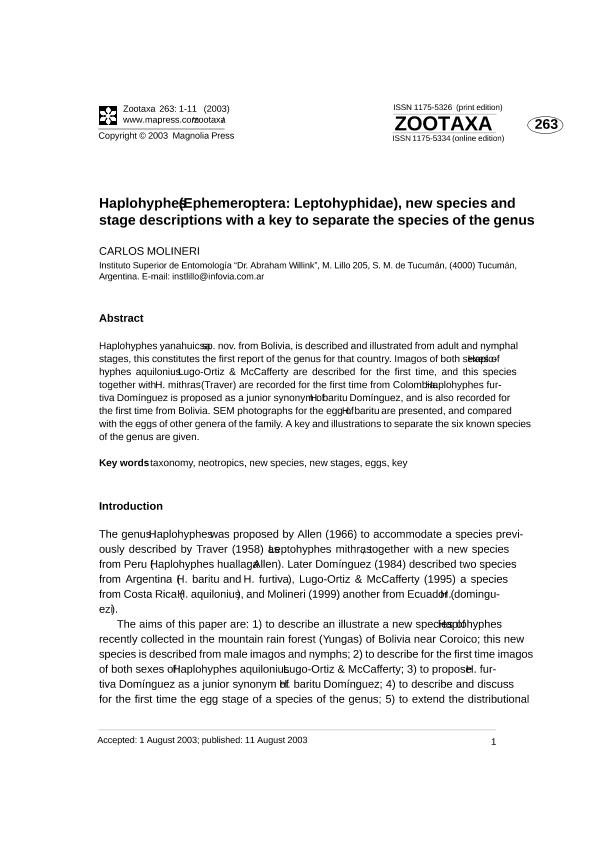Mostrar el registro sencillo del ítem
dc.contributor.author
Molineri, Carlos

dc.date.available
2020-07-22T15:41:16Z
dc.date.issued
2003-12
dc.identifier.citation
Molineri, Carlos; Haplohyphes (Ephemeroptera: Leptohyphidae), new species and; Magnolia Press; Zootaxa; 263; 12-2003; 1-11
dc.identifier.issn
1175-5326
dc.identifier.uri
http://hdl.handle.net/11336/109864
dc.description.abstract
Haplohyphes yanahuicsa sp. nov. from Bolivia, is described and illustrated from adult and nymphal stages, this constitutes the first report of the genus for that country. Imagos of both sexes of Haplohyphes aquilonius Lugo-Ortiz & McCafferty are described for the first time, and this species together with H. mithras (Traver) are recorded for the first time from Colombia. Haplohyphes furtivasp. nov. from Bolivia, is described and illustrated from adult and nymphal stages, this constitutes the first report of the genus for that country. Imagos of both sexes of Haplohyphes aquilonius Lugo-Ortiz & McCafferty are described for the first time, and this species together with H. mithras (Traver) are recorded for the first time from Colombia. Haplohyphes furtivaHaplohyphes aquilonius Lugo-Ortiz & McCafferty are described for the first time, and this species together with H. mithras (Traver) are recorded for the first time from Colombia. Haplohyphes furtivaLugo-Ortiz & McCafferty are described for the first time, and this species together with H. mithras (Traver) are recorded for the first time from Colombia. Haplohyphes furtivaH. mithras (Traver) are recorded for the first time from Colombia. Haplohyphes furtiva Domínguez is proposed as a junior synonym of H. baritu Domínguez, and is also recorded for the first time from Bolivia. SEM photographs for the egg of H. baritu are presented, and compared with the eggs of other genera of the family. A key and illustrations to separate the six known species of the genus are given.H. baritu Domínguez, and is also recorded for the first time from Bolivia. SEM photographs for the egg of H. baritu are presented, and compared with the eggs of other genera of the family. A key and illustrations to separate the six known species of the genus are given.H. baritu are presented, and compared with the eggs of other genera of the family. A key and illustrations to separate the six known species of the genus are given.
dc.format
application/pdf
dc.language.iso
eng
dc.publisher
Magnolia Press

dc.rights
info:eu-repo/semantics/openAccess
dc.rights.uri
https://creativecommons.org/licenses/by-nc-sa/2.5/ar/
dc.subject
neotropics
dc.subject
new species
dc.subject
new stages
dc.subject
eggs
dc.subject
key
dc.subject.classification
Ciencias de las Plantas, Botánica

dc.subject.classification
Ciencias Biológicas

dc.subject.classification
CIENCIAS NATURALES Y EXACTAS

dc.title
Haplohyphes (Ephemeroptera: Leptohyphidae), new species and
dc.type
info:eu-repo/semantics/article
dc.type
info:ar-repo/semantics/artículo
dc.type
info:eu-repo/semantics/publishedVersion
dc.date.updated
2020-07-20T15:36:47Z
dc.journal.volume
263
dc.journal.pagination
1-11
dc.journal.pais
Nueva Zelanda

dc.journal.ciudad
Auckland
dc.description.fil
Fil: Molineri, Carlos. Consejo Nacional de Investigaciones Científicas y Técnicas. Centro Científico Tecnológico Conicet - Tucumán. Instituto de Biodiversidad Neotropical. Universidad Nacional de Tucumán. Facultad de Ciencias Naturales e Instituto Miguel Lillo. Instituto de Biodiversidad Neotropical. Instituto de Biodiversidad Neotropical; Argentina
dc.journal.title
Zootaxa
dc.relation.alternativeid
info:eu-repo/semantics/altIdentifier/url/https://www.mapress.com/j/zt/article/view/zootaxa.263.1.1/7429
Archivos asociados
